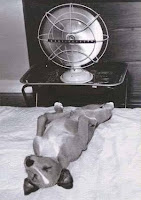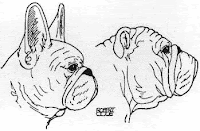Summer Heat Dangerous For Dogs

Since we’re stuck in the middle of yet another heat wave in the mid-Atlantic region, I wanted to take a moment to warn dog owners about their pets’ risk of heat stroke. In the past few weeks a number of dogs have been brought into Friendship after collapsing due to heat stroke. Several dogs have even died, which is truly tragic since this could have been easily avoided.
One of the recent fatalities was a bulldog that was taken out for fifteen minutes around noon as part of a mid-day walk. He collapsed on his walk and was immediately rushed to Friendship. Sadly, despite aggressive treatment, complications from heat stroke damaged his organs so severely that he had to be euthanized the next day.


drawing by Robert Cole
What makes heat stroke potentially fatal is that the patient can develop a condition called disseminated intravascular coagulation (DIC) that causes massive and widespread damage to the blood vessels. This quickly results in multiple organ failure and the patient loses the ability to clot his blood. Treatment consists of aggressive supportive care and plasma transfusions, both of which are very expensive and not guaranteed to prevent death.
- Avoid taking your dog out during the hottest times of the day. (Quick rule of thumb: If it is too hot for you, then it is definitely too hot for your dog!)
- Keep an eye out for unusual behavior: If you are out in the hot weather with your dog and he slows down, lies down or acts reluctant to keep walking, you should let him rest, offer him cool water and head inside immediately.
- Make sure your dog has cool, fresh water available at all times.
- Never leave a dog (or any other pet) in a parked car when it is even slightly warm out. The temperature in the car can rise amazingly quickly and before you know it you have an overheated animal.
- Don’t take your dog running. (I am never a fan of running with your dog—check out this article to see why--but in this weather it is an especially bad idea).








No comments:
Post a Comment